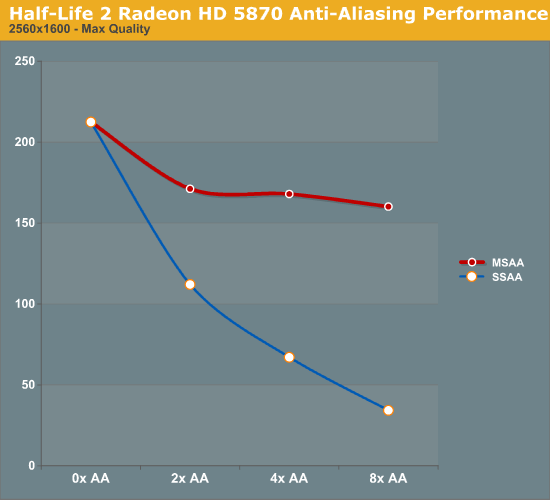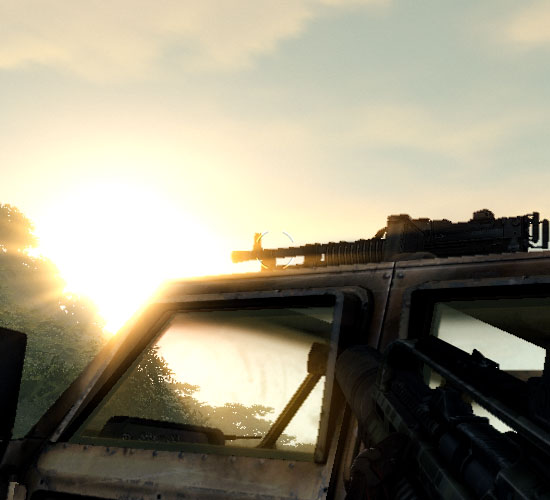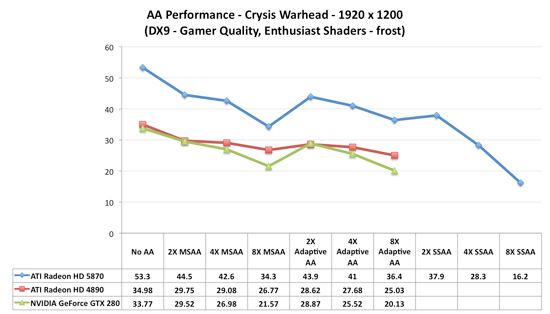AMD's Radeon HD 5870: Bringing About the Next Generation Of GPUs
by Ryan Smith on September 23, 2009 9:00 AM EST- Posted in
- GPUs
AA Image Quality & Performance
With HL2 unsuitable for use in assessing image quality, we will be using Crysis: Warhead for the task. Warhead has a great deal of foliage in parts of the game which creates an immense amount of aliasing, and along with the geometry of local objects forms a good test for anti-aliasing quality. Look in particular at the leaves both to the left and through the windshield, along with aliasing along the frame, windows, and mirror of the vehicle. We’d also like to note that since AMD’s SSAA modes do not work in DX10, this is done in DX9 mode instead.
|
AMD Radeon HD 5870
|
AMD Radeon HD 4870
|
NVIDIA GTX 280
|
| No AA | ||
| 2X MSAA | ||
| 4X MSAA | ||
| 8X MSAA | ||
| 2X MSAA +AAA | 2X MSAA +AAA | 2X MSAA + SSTr |
| 4X MSAA +AAA | 4X MSAA +AAA | 4X MSAA + SSTr |
| 8X MSAA +AAA | 8X MSAA +AAA | 8X MSAA + SSTr |
| 2X SSAA | ||
| 4X SSAA | ||
| 8X SSAA |
From an image quality perspective, very little has changed for AMD compared to the 4890. With MSAA and AAA modes enabled the quality is virtually identical. And while things are not identical when flipping between vendors (for whatever reason the sky brightness differs), the resulting image quality is still basically the same.
For AMD, the downside to this IQ test is that SSAA fails to break away from MSAA + AAA. We’ve previously established that SSAA is a superior (albeit brute force) method of anti-aliasing, but we have been unable to find any scene in any game that succinctly proves it. Shader aliasing should be the biggest difference, but in practice we can’t find any such aliasing in a DX9 game that would be obvious. Nor is Crysis Warhead benefitting from the extra texture sampling here.
From our testing, we’re left with the impression that for a MSAA + AAA (or MSAA + SSTr for NVIDIA) is just as good as SSAA for all practical purposes. Much as with the anisotropic filtering situation we know through technological proof that there is better method, but it just isn’t making a noticeable difference here. If nothing else this is good from a performance standpoint, as MSAA + AAA is not nearly as hard on performance as outright SSAA is. Perhaps SSAA is better suited for older games, particularly those locked at lower resolutions?
For our performance data, we have two cases. We will first look at HL2 on only the 5870, which we ran before realizing the quality problem with Source-engine games. We believe that the performance data is still correct in spite of the visual bug, and while we’re not going to use it as our only data, we will use it as an example of AA performance in an older title.

As a testament to the rendering power of the 5870, even at 2560x1600 and 8x SSAA, we still get a just-playable framerate on HL2. To put things in perspective, with 8x SSAA the game is being rendered at approximately 32MP, well over the size of even the largest possible single-card Eyefinity display.
Our second, larger performance test is Crysis: Warhead. Here we are testing the game on DX9 mode again at a resolution of 1920x1200. Since this is a look at the impact of AA on various architectures, we will limit this test to the 5870, the GTX 280, and the Radeon HD 4890. Our interest here is in performance relative to no anti-aliasing, and whether different architectures lose the same amount of performance or not.
Starting with the 5870, moving from 0x AA to 4x MSAA only incurs a 20% drop in performance, while 8x MSAA increases that drop to 35%, or 80% of the 4x MSAA performance. Interestingly, in spite of the heavy foliage in the scene, Adaptive AA has virtually no performance hit over regular MSAA, coming in at virtually the same results. SSAA is of course the big loser here, quickly dropping to unplayable levels. As we discussed earlier, the quality of SSAA is no better than MSAA + AAA here.
Moving on, we have the 4890. While the overall performance is lower, interestingly enough the drop in performance from MSAA is not quite as much, at only 17% for 4x MSAA and 25% for 8x MSAA. This makes the performance of 8x MSAA relative to 4x MSAA 92%. Once again the performance hit from enabling AAA is miniscule, at roughly 1 FPS.
Finally we have the GTX 280. The drop in performance here is in line with that of the 5870; 20% for 4x MSAA, 36% for 8x MSAA, with 8x MSAA offering 80% of the performance. Even enabling supersample transparency AA only knocks off 1 FPS, just like AAA under the 5870.
What this leaves us with are very curious results. On a percentage basis the 5870 is no better than the GTX 280, which isn’t an irrational thing to see, but it does worse than the 4890. At this point we don’t have a good explanation for the difference; perhaps it’s a product of early drivers or the early BIOS? It’s something that we’ll need to investigate at a later date.
Wrapping things up, as we discussed earlier AMD has been pitching the idea of better 8x MSAA performance in the 5870 compared to the 4800 series due to the extra cache. Although from a practical perspective we’re not sold on the idea that 8x MSAA is a big enough improvement to justify any performance hit, we can put to rest the idea that the 5870 is any better at 8x MSAA than prior cards. At least in Crysis: Warhead, we’re not seeing it.












327 Comments
View All Comments
SiliconDoc - Sunday, September 27, 2009 - link
I'll be watching you for the very same conclusion when NVidia launches soft and paper.I'll bet ten thousand bucks you don't say it.
I'll bet a duplicate amount you're a red rager fan, otherwise YOU'D BE HONEST, NOT HOSTILE !
rennya - Thursday, September 24, 2009 - link
It may be paper-launch in the US, but here somewhere in South East Asia I can already grab a Powercolor 5870 1GB if I so desire. Powercolor is quite aggresive here promoting their ATI 5xxx wares just like Sapphire does when the 4xxx series comes out.SiliconDoc - Thursday, September 24, 2009 - link
I believe you. I've also seen various flavors of cards not available here in the USA, banned by the import export deals and global market and manufacturer and vendor controls and the powers that be, and it doesn't surprise me when it goes the other way.Congratulations on actually having a non fake launch.
Spoelie - Wednesday, September 23, 2009 - link
"The engine allows for complete hardware offload of all H.264, MPEG-2 and VC1 decoding".This has afaik never been true for any previous card of ATi, and I doubt it has been tested to be true this time as well.
I have detailed this problem several times before in the comment section and never got a reply, so I'll summarize: ATi's UVD only decodes level 4 AVC (i.e. bluray) streams, if you have a stream with >4 reference frames, you're out of luck. NVIDIA does not have this limitation.
lopri - Wednesday, September 23, 2009 - link
Yeah and my GTX 280 has to run full throttle (3D frequency) just to play a 720p content and temp climbs the same as if it were a 3D game. Yeah it can decode some *underground* clips from Japan, big deal. Oh and it does that for only H.264. No VC-1 love there. I am sure you'd think that is not a big deal, but the same applies to those funky clips with 13+ reference frames. Not a big deal. Especially when AMD can decode all 3 major codecs effortlessly (performance 2D frequency instead of 3D frequency)rennya - Thursday, September 24, 2009 - link
G98 GPUs (like 8400GS discrete or 9400 chipset) or GT220/G210 can also do MPEG2/VC-1/AVC video decoding.The GPU doesn't have to run full throttle either, as long as you stick to the 18x.xx drivers.
SJD - Wednesday, September 23, 2009 - link
Ryan,Great article, but there is an inconsistancy. You say that thanks to there only being 2 TDMS controllers, you can't use both DVI connectors at the same time as the HDMI output for three displays, but then go onto say later that you can use the DVI(x2), DP and HDMI in any combination to drive 3 displays. Which is correct?
Also, can you play HDCP protected content (a Blu-Ray disc for example) over a panel connected to a Display Port connector?
Otherwise, thanks for the review!
Ryan Smith - Wednesday, September 23, 2009 - link
It's the former that is correct: you can only drive two TDMS devices. The article has been corrected.And DP supports HDCP, so yes, protected content will play over DP.
SJD - Friday, September 25, 2009 - link
Thanks for clarifying that Ryan - It confirms what I thought.. :-)chowmanga - Wednesday, September 23, 2009 - link
I'd like to see a benchmark using an amd cpu. I think it was the Athlon II 620 article that pointed out how Nvidia hardware ran better on AMD cpus and AMD/ATI cards ran better on Intel cpus. It would be interesting to see if the 5870 stacks up against Nv's current gen with other setups.